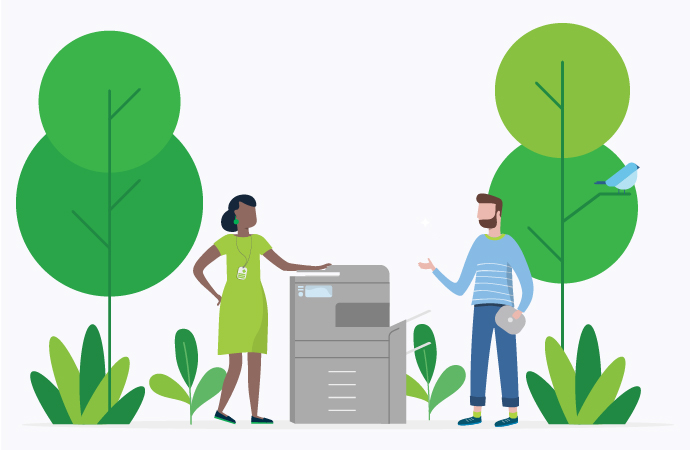Fifteen years ago, our CEO and co-founder Chris Dance put together his Top 10 tips to save paper. And do you know what? They’re even more relevant today. Roughly 10% of the world’s population, including Western Europe and North America, account for over half the world’s paper consumption. Paper makes up about 26% of landfill waste, and the average office worker in Western, industrialized countries uses roughly 10,000 sheets of paper every year! That’s a lot of trees.
Printing will always be an important part of commercial office life, but it’s hard to run a sustainable business without paper conservation and environmentally friendly printing. It might sound weird coming from a print-management software company, but we really do encourage you to print less, not more. We’re all for thoughtful printing.
With that in mind, here are PaperCut’s Top ten tips for eco-friendly printing.
1. Print duplex or two to a page
Printing on both sides of the page (duplex) or printing two pages to a single side (also called N-Up printing), is a great eco-friendly printing alternative. You can even combine both these techniques to print four pages per piece of paper! This not only saves paper; it also means it’ll take longer to reach your print quota !
2. Use PDF and go digital
Try sending business documents via e-mail in PDF format, rather than printing and then faxing/mailing them. In the vast majority of cases, you no longer need to print, sign, and send these days, especially with the advent of electronic signatures. While you’re at it, consider a fax-to-email gateway, so any inbound faxes arrive direct in your inbox.
3. Use an electronic diary
I know physical diary users are still out there. I see the previous year’s diaries in the dollar bins at newsagents each year! Install a program on your laptop or computer and record all appointments and diary entries electronically. Google Calendar is our program of choice, but there are plenty of great third-party apps out there.
4. Send e-cards
Save money and save the planet. Personalised season’s greetings can be sent quickly and easily by email. Save on stamps, cards and envelopes. Note: Some may thing you’re “cheap” doing this so make it known that your driver is not cost savings but the environment!
5. Switch to online forms
With so many great digital survey tools out there – Google Forms, Mailchimp, SurveyMonkey and Jotform, just to name a few – there’s really no need for paper-based forms anymore. Not only are digital forms cheaper and better for the environment, they’re also easier to integrate with your CMS or data-management system. Most don’t even require Wi-Fi.
6. Electronic memos and bulletins
Wherever you can, try and communicate in the office electronically. Invitations, instructions, and important notices can be sent via email or posted in the company Slack channel. If you have to print a bulletin or announcement, try posting one copy in a central place, rather than distributing pages all over the office.
7. Be selective
Print only what you need to print. It sounds simple, but every office can benefit from this tip. Cut and paste relevant information from longer documents and print only when and what you absolutely need to. Before you click ‘CTRL + P’, just stop and think: could this be an email attachment?
8. Proof your work on screen
Some people prefer to print documents for proofing, as it’s difficult and taxing to do so on the screen. Be kind to your eyes and simply enlarge the text while you proof. You should also preview documents before printing, to eliminate any obvious formatting errors or typos. It’s a couple of extra clicks, but it can save a lot of paper. Don’t forget to check the margins – that’s a common printing mistake.
9. Promote awareness
Place signs around your office encouraging eco-friendly printing and promoting paper-saving tips. Laminate them so you don’t have to reprint them! Saving printer paper is all about breaking bad habits and getting into new ones. The more you gently remind people to do the right thing, the better your chances of making a change.
10. Recycle, recycle, recycle
Have recycle bins in prominent places so people remember to use them. You can also print on the back of scrap documents if the file isn’t important or client-facing. Lastly, don’t forget to buy recycled copy paper wherever possible. Opt for thinner paper for eco-friendly printing – around 60gsm to 70gsm is the sweet spot. These sheets use less raw materials, and they’re cheaper too. Win/win.




